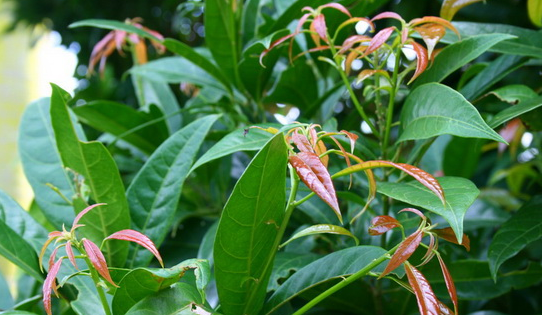Butterfly fruit (scientific name: Cleidiocarpon cavaleriei (Levl.) Airy Shaw) is a large genus, a genus of the genus Panthera, up to 25 meters high; young branches, leaves sparse microstellate hair, and later hairless. It is distributed in southern Guizhou, northwestern Guangxi, western and southwestern China, and southeastern Yunnan. Born in a hillside or gully evergreen forest at an altitude of 150-1 000 m in the mountains or limestone mountains. There are also distributions in northern Vietnam.

Potted fruit of butterfly fruit
The seeds are rich in starch and oil, which can be eaten after cooking and removing the embryos; the wood is suitable for furniture; the tree is beautiful, evergreen, and has strong disease resistance. Now it is cultivated in Guangzhou, Hainan, Suichang and other places for street trees or garden greening. tree. Let's share the potting technique of the butterfly fruit.
Cultivation Techniques:
1, the upper pot transplanting
Select strong branches and peel off the bark from about 15 to 30 cm below the top. The width of the stripped skin is about one centimeter, and the depth is just peeled off the skin. Cut a piece of film 10 to 20 cm long and 5 to 8 cm wide. Place some wet garden soil on it, and wrap the stripped part like a wound. The upper and lower ends of the film are tight and the middle is bulged. Rooting after about four to six weeks. After rooting, the roots of the branches are cut together to form a new plant.
2, temperature management
Because it is native to the subtropical region, the temperature requirements for winter are very strict, and growth stops when the ambient temperature is below 8 °C.
3, lighting management
Strong ability to adapt to light. When placed indoors, try to place it in a place with bright light, such as a well-lit living room, bedroom, study, etc. After curing indoors for a period of time (about one month), it is necessary to move it to a place where there is shading outside (the winter has insulation conditions) for a period of time (about one month), so alternately exchanged.
4, fertilizer management
For potted plants, in addition to the addition of organic fertilizer in the upper basin, proper fertilizer management should be carried out during the usual maintenance process.
(1) Summer and autumn three seasons: These three seasons are its growing season, and the management of fertilizer and water is cycled according to the “Huabao” – Qingshui – “Huabao” – clear water, with an interval of about 1 to 4 days, sunny. Or the interval period of the high temperature period is shorter, and the interval period of the rainy or low temperature period is longer or not.
(2) Winter: During the winter dormancy period, the main thing is to control the fertilizer and control the water. The management of fertilizer and water is in accordance with the “Huabao” – Qingshui – Qingshui – “Huabao” – Qingshui – clear water cycle, interval period For about 3 to 7 days, for plants planted in the ground, apply 2 to 4 times of fertilizer according to the drought conditions in spring and summer: firstly divide the small ditch from 30 to 100 mm outside the root and neck (the larger the plant, the more The farther the neck and neck are, the wider and deeper the groove is 20 cm. Sprinkle 25 to 50 kg of organic fertilizer in the ditch, or 1 to 5 two-part compound fertilizer (fertilizer), and then pour water. Before the spring, after the spring, fertilize again according to the above method, but do not need to water.
5, pruning
In winter, when the plant enters a dormant or semi-dormant period, it is necessary to cut off thin, pest, dead, over-density and other branches. The branches can also be combined with cuttings.
6, change basin maintenance
As long as it is cured, it will grow very quickly. When growing to a certain size, consider changing it to a larger basin to allow it to continue to grow vigorously. The culture soil and component ratio for basin change can be selected from the following ones: vegetable garden soil: slag = 3:1; or garden soil: medium coarse river sand: sawdust (slag) = 4:1:2; or paddy soil One of the pond mud and the humus soil.
(1) De-washing: Put the flower to be changed on the ground, first use the slap to pat the circumference of the basin, so that the root is shaken and separated from the basin wall. Turn the flowerpot upside down on the left hand, the index finger and middle finger of the left hand. Gently clamp the plant, the wrist and fingertips are placed against the basin edge, the right hand taps the pelvic floor, and then the mother finger is used to push the roots down from the bottom hole to allow the plant to come out. After taking it out, gently tap the potting soil with both palms to let the excess soil fall off.
(2) Preparation of flower pots: Select a flower pot of appropriate size. The bottom hole of the pot is covered with two tiles or a thin piece of foam. It is necessary to ensure that the potting soil is not washed out by water, and that it must be redundant. Water can flow out in time. Place a layer of ceramsite or broken red brick on the tile or foam as a drainage layer, about 23 cm thick. The fertilizer layer is placed on the drainage layer, about 1 to 3 cm thick, and a thin layer of substrate on the fertilizer, about 2 cm thick, to separate the roots from the fertilizer, and finally put the plants in, fill the nutrient soil, and leave the basin. The mouth is about 2 to 3 cm.
Contact: Mr. Ma
Phone: +86-0374-5699688
Tel: +86-0374-5699688
Email: [email protected]
Add: Fine Chemical Industry Park, Jianan District, Xuchang, Henan, China